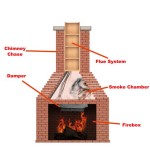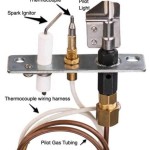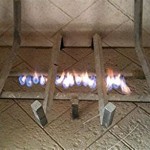Understanding Gas Fireplace Remotes: A Comprehensive Guide
Gas fireplace remotes offer a convenient and efficient way to control the operation of a gas fireplace. These devices, often underestimated, play a crucial role in enhancing user experience, improving energy efficiency, and ensuring safe operation. This article provides a comprehensive understanding of gas fireplace remotes, encompassing their functionality, types, troubleshooting, and maintenance.
The primary function of a gas fireplace remote is to transmit commands to the fireplace's control module. These commands can include igniting the pilot light, adjusting the flame height, turning the fireplace on or off, and managing auxiliary functions such as blowers or accent lighting. The communication between the remote and the fireplace relies on radio frequency (RF) or infrared (IR) signals. Understanding the underlying technology is vital for effective utilization and troubleshooting.
Key Point 1: Types of Gas Fireplace Remotes
Gas fireplace remotes are not universally compatible; they come in several varieties, each with unique features and functionalities. The selection of an appropriate remote depends on the fireplace model and the desired level of control.
On/Off Remotes: These are the most basic type of gas fireplace remote. They provide simple on/off functionality, allowing users to ignite or extinguish the flame without manual intervention. These remotes are generally compatible with fireplaces equipped with a simple millivolt system.
Thermostatic Remotes: Thermostatic remotes offer temperature control capabilities. They incorporate a built-in thermostat that monitors the room temperature and adjusts the flame height accordingly. This type of remote allows users to maintain a consistent and comfortable temperature within the room. Some advanced models feature programmable thermostats, enabling users to set specific temperature schedules throughout the day.
Modulating Remotes: Modulating remotes provide precise control over the flame height. These remotes allow users to adjust the flame intensity to suit their preferences or energy-saving needs. They often feature multiple flame height settings and may include a timer function for automatic shutdown.
Learning Remotes: Learning remotes, also known as universal remotes, are designed to be compatible with a wide range of gas fireplaces. These remotes can learn the control codes from the original remote, allowing users to control multiple devices, including the fireplace, with a single remote. The learning process involves pointing the original remote at the learning remote and following the specified programming instructions.
Smart Remotes: Smart remotes represent the latest advancement in gas fireplace remote technology. These remotes connect to a home's Wi-Fi network and can be controlled via a smartphone app or voice assistants like Amazon Alexa or Google Assistant. Smart remotes offer advanced features such as remote monitoring, energy usage tracking, and integration with other smart home devices. Remote monitoring ensures the fireplace is off when no one is home, for example.
The choice between these options will depend entirely on the existing fireplace's capabilities and the needs of the user. Matching the remote to the system is vital for safe and effective operation.
Key Point 2: Troubleshooting Common Remote Problems
Gas fireplace remotes, like any electronic device, can experience malfunctions. Troubleshooting common issues can often restore functionality and prevent unnecessary service calls. Several factors can affect remote performance, including battery life, signal interference, and receiver malfunctions.
Battery Issues: Low battery power is a common cause of remote malfunction. Replacing the batteries with fresh ones is often the first step in troubleshooting. Ensure that the batteries are installed correctly, observing the correct polarity symbols. Some remotes require specific types of batteries, such as alkaline or lithium, so consult the user manual for guidance.
Signal Interference: Gas fireplace remotes rely on RF or IR signals to communicate with the fireplace control module. Interference from other electronic devices, such as cordless phones or microwaves, can disrupt the signal and prevent the remote from functioning properly. Try moving the remote closer to the fireplace or removing potential sources of interference to improve signal strength. For RF remotes, consider changing the frequency channel if interference persists.
Receiver Malfunctions: The fireplace control module, also known as the receiver, can also experience malfunctions. Check the receiver's power supply and connections to ensure it is functioning correctly. Some receivers have a reset button that can be used to restore the device to its default settings. Consult the fireplace's user manual for specific troubleshooting instructions related to the receiver.
Pilot Light Issues: Sometimes, a remote issue can be mistaken for a pilot light problem. Ensure the pilot light is lit before troubleshooting the remote. A faulty thermocouple or gas valve can prevent the pilot light from staying lit, rendering the remote inoperable.
Remote Programming: Some remotes require initial programming or re-programming after a battery change. Consult the user manual for instructions on how to program the remote to communicate with the fireplace receiver. The programming process typically involves pressing a specific sequence of buttons on the remote and the receiver.
Physical Damage: Inspect the remote for any signs of physical damage, such as cracks or broken buttons. A damaged remote may require replacement or repair. Avoid dropping the remote or exposing it to extreme temperatures or humidity, as these factors can damage the internal components.
If troubleshooting the remote does not resolve the issue, it is best to consult a qualified gas fireplace technician. Attempting to repair the fireplace or remote yourself can be dangerous and may void the warranty.
Key Point 3: Ensuring Safe and Efficient Operation
The safe and efficient operation of a gas fireplace and its remote requires adherence to specific guidelines and practices. Proper maintenance, regular inspections, and responsible usage are essential for preventing accidents and ensuring optimal performance.
Regular Inspections: Schedule regular inspections of the gas fireplace and its components, including the remote, by a qualified technician. Inspections should include checking for gas leaks, inspecting the venting system, and verifying the proper operation of the safety features. A professional inspection will help identify potential problems before they become serious hazards.
Ventilation: Ensure proper ventilation when operating the gas fireplace. Carbon monoxide poisoning is a serious risk associated with improperly vented gas appliances. Install carbon monoxide detectors in the home and test them regularly to ensure they are functioning correctly. Never block or obstruct the fireplace's venting system.
Remote Placement: Store the remote in a safe and easily accessible location. Avoid placing the remote near heat sources or in direct sunlight, as these factors can damage the device. Keep the remote out of reach of children and pets to prevent accidental operation or damage.
Safe Usage Practices: Always follow the manufacturer's instructions when operating the gas fireplace and its remote. Never leave the fireplace unattended while it is in operation. Turn off the fireplace before leaving the room or going to bed. Do not use the fireplace to dry clothes or other flammable items. Ensure that all combustible materials are kept a safe distance from the fireplace.
Childproofing Measures: Implement childproofing measures to prevent children from tampering with the gas fireplace or its remote. Install a safety screen around the fireplace to prevent accidental burns. Store the remote in a location that is inaccessible to children. Educate children about the dangers of playing with the fireplace and its controls.
Energy Efficiency: Utilize the remote's features to optimize energy efficiency. Use the thermostatic control to maintain a consistent temperature and avoid overheating the room. Adjust the flame height to suit your heating needs and conserve energy. Consider using a programmable thermostat to set specific temperature schedules and reduce energy consumption during periods of inactivity.
Professional Maintenance: Schedule regular maintenance of the gas fireplace by a qualified technician. Maintenance should include cleaning the burner assembly, inspecting the gas lines, and verifying the proper operation of the safety features. Professional maintenance will help extend the lifespan of the fireplace and ensure its safe and efficient operation.
By following these guidelines and practices, users can ensure the safe and efficient operation of their gas fireplace and its remote, maximizing comfort and minimizing risks.
Gas fireplace remotes are an integral part of modern fireplace systems. Understanding their various types, common problems, and safe operating procedures can improve the overall fireplace experience. Adhering to maintenance schedules and employing preventative measures ensures prolonged performance and reduces the risk of unexpected issues.

Gas Fireplace Remotes More Fireplaceremotecontrols Com

Skytech 1001 On Off Fireplace Remote Control

Gas Fireplace Remote Control Guide Fireplaces Direct Learning Center

Fireplace Thermostats Remote Controls Friendly Fires

Gas Fireplace Remotes More Fireplaceremotecontrols Com

Gas Fireplace Remotes More Fireplaceremotecontrols Com

Sit Gas Fireplace Or Stove Remote Control Wall Bracket Hechler S Mainstreet Hearth Home Troy Missouri

Everwarm Thermostat Remote Control Us Fireplace

Kingsman Fireplaces Gtrc Remote Control Millivolt Thermostat

Gas Fireplace Remote Control Guide Fireplaces Direct Learning Center
Related Posts








